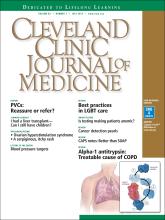Article Figures & Data
Tables
Cancer type Estimated new cases Estimated deaths Both sexes Male Female Both sexes Male Female Breast 234,190 2,350 231,840 40,730 440 40,290 Colorectal 132,700 69,090 63,610 49,700 26,100 23,600 Prostate 220,800 220,800 0 27,540 27,540 0 Lung 221,200 115,610 105,590 158,040 86,380 71,660 Hodgkin lymphoma 9,050 5,100 3,950 1,150 660 490 Testicular 8,430 8,430 0 380 380 0 Based on information from the American Cancer Society, reference 2.
American Cancer Society11 US Preventive Services Task Force13 National Comprehensive Cancer Network12 Women ages 40 to 44 should have the choice to start annual breast cancer screening with mammography. The risks of screening and the potential benefits should be considered
Women ages 45 to 54 should undergo mammography every year.
Women age 55 and older should switch to mammography every 2 years, or have the choice to continue yearly screening.The decision to start regular biennial screening mammography (ie, every 2 years) before age 50 should be an individual one and should take patient context into account, including the patient’s values regarding specific benefits and harms.
Biennial screening mammography for women ages 50 to 74.Women age 40 and older should have an annual breast examination, annual screening mammography, and education about breast cancer awareness.
Women should be counseled on the potential benefits, risks, and limitations of breast cancer screening.American Cancer Society23 US Preventive Services Task Force24 National Comprehensive Cancer Network12 Beginning at age 50, men and women should use one of the screening tests below:
Tests that find polyps and cancer (preferred):
Flexible sigmoidoscopy every 5 years
Colonoscopy every 10 years
Double-contrast barium enema every 5 years
Computed tomographic colonography every 5 years
Tests that find cancer only:
Guaiac-based fecal occult blood test every year Fecal immunochemical test every year Stool DNA test every 3 yearsScreen for colorectal cancer using fecal occult blood testing, sigmoidoscopy, or colonoscopy in adults beginning at age 50 and continuing until age 75. The risks and benefits of these screening methods vary.
The evidence is insufficient to assess the benefits and harms of computed tomographic colonography and fecal DNA testing as screening modalities for colorectal cancer.Patients age 50 and older should be screened for colorectal cancer with colonoscopy, high-sensitivity guaiac- based or immunochemical testing, or flexible sigmoidoscopy, plus or minus interval stool-based testing at year 3. American Cancer Society26 US Preventive Services Task Force27 National Comprehensive Cancer Network12 Men should make an informed decision with their physician about whether to be screened based on an understanding of the uncertainties, risks, and benefits of screening. The discussion about screening should take place at:
Age 50 for men at average risk of prostate cancer with a life expectancy of at least 10 years
Age 45 for men at high risk of prostate cancer (blacks, men with a first-degree relative diagnosed with prostate cancer before age 65)
Age 40 for men at even higher risk (more than one first-degree relative diagnosed with prostate cancer at an early age).Recommends against screening with prostate-specific antigen testing. Based on family history, race, and a history of prostate disease and screening, men ages 45 to 75 should have a discussion with their physician about the risks and benefits of prostate cancer screening, including prostate-specific antigen testing and digital rectal examination. American Cancer Society33 US Preventive Services Task Force35 National Comprehensive Cancer Network12,34 Patients who meet all of the following criteria may be candidates for lung cancer screening: Age 55 to 74
In fairly good health
Smoking history > 30 pack-years
Currently smoking or having quit smoking within the last 15 years.
Annual screening for lung cancer with low-dose computed tomography in adults ages 55 to 80 who have a 30-pack-year smoking history and who currently smoke or have quit within the past 15 years. Screening should be discontinued once a person has not smoked for 15 years or develops a health problem that substantially limits life expectancy or the ability or willingness to have curative lung surgery. For patients at high risk (ages 55 to 74 with a 30-pack-year or greater smoking history, smoking cessation less than 15 years ago)
OR
Age 55, with a 20-pack-year smoking history, and one additional risk factor other than second-hand smoke.






